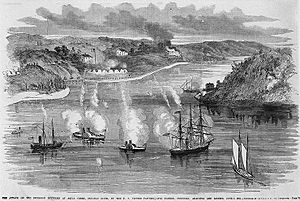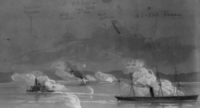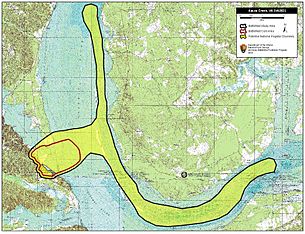Battle of Aquia Creek facts for kids
Quick facts for kids Battle of Aquia Creek |
|||||||
|---|---|---|---|---|---|---|---|
| Part of the American Civil War | |||||||
 "The Attack on the Secession Batteries at Aquia Creek, Potomac River, by the U.S. Vessels Pawnee, Live Yankee, Freeborn, Anacostia and Lioness, June 1, 1861." |
|||||||
|
|||||||
| Belligerents | |||||||
| Commanders and leaders | |||||||
| Strength | |||||||
| 1 sloop-of-war 3 gunboats |
13 artillery pieces 2 shore batteries |
||||||
| Casualties and losses | |||||||
| 9 wounded 1 sloop damaged 1 gunboat damaged |
1 wounded | ||||||
The Battle of Aquia Creek was a fight between ships of the Union Navy and cannons on shore, controlled by the Confederates. It happened on the Potomac River in Stafford County, Virginia. This battle took place from May 29 to June 1, 1861, at the very start of the American Civil War.
The Confederates had placed cannons along the shore. These "shore batteries" were meant to stop Union ships. They wanted to block military and trade vessels from using the Chesapeake Bay and the lower Potomac River. The battery at Aquia also protected a railroad station there.
The Union forces wanted to destroy these cannons. They were trying to blockade, or block, Confederate ports. The battle ended without a clear winner. Neither side caused much damage or many injuries. The Union ships could not make the Confederates leave their positions. The Confederates could not seriously harm the Union sailors or their ships.
Later, on July 7, 1861, the Confederates tried to use naval mines for the first time. They placed them near the Aquia Landing batteries, but they didn't work. The Confederates finally left these batteries on March 9, 1862. They moved their troops to defend against the Union Army's Peninsula Campaign. The U.S. National Park Service lists this as one of the main battles of the Civil War.
Why the Battle Happened
Virginia voted to leave the Union on April 17, 1861. This happened just after Fort Sumter fell to Confederate forces. President Abraham Lincoln then asked for volunteers to stop the rebellion.
On April 22, 1861, Virginia's Governor John Letcher put Robert E. Lee in charge of Virginia's state forces. General Lee sent Captain William F. Lynch to find good places for cannons along the Potomac River. These cannons would stop Union ships from using the river.
On April 24, 1861, engineers looked at Aquia Creek. They chose a spot called Split Rock Bluff for a battery. They thought it was the best place to control the river with cannons.
On April 27, 1861, President Lincoln ordered a blockade of the Confederacy. This blockade now included the coasts of Virginia and North Carolina. Both the Union and the Confederacy wanted to control the Potomac River.
On May 8, 1861, work began on the Aquia Creek defenses. The main goal was to protect the railroad terminal there. Around May 14, Captain Lynch and his team set up 13 cannons at Aquia. These cannons protected the railroad and threatened to close the Potomac River.
On May 10, 1861, General Lee took command of Confederate troops in Virginia. Brigadier General Daniel Ruggles took charge of the batteries. Captain Lynch remained in direct command at Aquia.
The Union ship USS Mount Washington (1846) (USS Mount Vernon) first saw the Confederate battery on May 14, 1861. But the Mount Vernon did not attack. The first battery was at river level to protect the railroad. So, before May 29, 1861, the Confederates added a second battery. This one was on top of the bluffs, south of where Aquia Creek meets the Potomac River.
The Battle Itself

On May 29, 1861, the USS Thomas Freeborn attacked the Confederate batteries. This Union ship had 3 cannons and was led by Commander James H. Ward. The attack did little damage. Confederate Captain Lynch reported that the Thomas Freeborn fired 14 shots. Only one man was wounded in the hand.
The next day, May 30, the Thomas Freeborn returned. It was joined by the USS Anacostia and the USS Resolute. They fired at the Confederate batteries for several hours. Again, there was little effect. The biggest cannons on the Union ships were 32-pounders.
On June 1, the Thomas Freeborn, Anacostia, Resolute, and the USS Pawnee bombarded the batteries. They fired for almost 5 hours, shooting over 500 rounds. Captain Lynch said no one was killed or injured on the second and third days. He only reported the death of a chicken and a horse.
Lynch said his defenses were somewhat damaged. Houses behind the batteries were hit, and the railroad was torn up in a few spots. He fired back only a little to save ammunition. He could only shoot when the Union ships were in view. His big cannons could not be turned easily.
During the fight, both the Thomas Freeborn and the Pawnee were slightly damaged. They needed repairs. No Union sailors were seriously hurt or killed.
What Happened Next
On June 27, 1861, Commander James Harmon Ward was killed. He was the first United States Navy officer to die in the Civil War. He was killed while his ship, the Thomas Freeborn, supported a landing party. This party was trying to silence another Confederate battery at Mathias Point.
After the Battle of Aquia Creek, the Confederates made their defenses stronger. They built a third battery on the bluff at Aquia. They also built a fourth battery across the mouth of Aquia Creek at Brent Point.
On July 7, Confederates placed mines in the Potomac River near Aquia Creek. This was the first time mines were used in the war. The mines were large barrels with gunpowder. Sailors from the Pawnee saw them floating towards their ship. Sailors from the Resolute later removed the mines from the river. One of the mines sank.
By late October 1861, the Confederate batteries had effectively closed the Potomac River for a short time. The Union Navy later realized that the batteries could not hit moving ships. This was probably because of poor quality gunpowder. Even so, the Navy stopped civilian ships from using the Potomac River. They worried the Confederates might get a lucky hit.
After Major General George B. McClellan took command of the Union Army in November 1861, President Lincoln asked him to remove the Confederates from these positions many times. But McClellan did not move. Lincoln finally ordered McClellan to act on March 8, 1862. But by then, the Confederates had already left.
The Confederates abandoned the batteries in early March 1862. General Joseph E. Johnston called their soldiers away. He needed them to defend Richmond at the start of the Peninsula Campaign. On March 9, 1862, sailors on the Anacostia and USS Yankee saw fires and explosions. They discovered that the Confederate batteries at Aquia and along the Potomac River were empty.
The Union Army used the docks and storage buildings at Aquia Landing. They used them until June 7, 1863, when the army moved north for the Battle of Gettysburg. The Union Army used the facilities again in 1864 during the Overland Campaign.
Images for kids



